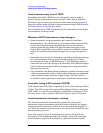
76 Chapter 2
Programming Fundamentals
Using the Instrument Status Registers
Using the Instrument Status Registers
When you are programming the instrument you may need to monitor
instrument status to check for error conditions or monitor changes.You
can determine the state of certain instrument events/conditions by
programming the status register system. IEEE common commands
(those beginning with *) access the higher-level summary registers. To
access the information from specific registers you would use the
STATus commands.
Using the Status Registers
Figure on page 82 shows the available instrument status registers and
their hierarchy.
• “What are the Status Registers?” on page 76.
• “Why Would You Use the Status Registers?” on page 78.
• “Using a Status Register” on page 80.
• “Using the Service Request (SRQ) Method” on page 80.
• “What are the Status Registers?” on page 76.
• “Standard Event Status Register” on page 86.
• “Operation and Questionable Status Registers” on page 88.
What are the Status Registers?
The status system is comprised of multiple registers which are
arranged in a hierarchical order. The lower-level status registers
propagate their data to the higher-level registers in the data structures
by means of summary bits. The status byte register is at the top of the
hierarchy and contains general status information for the instrument’s
events and conditions. All other individual registers are used to
determine the specific events or conditions.
The operation and questionable status registers are sets of registers
that monitor the overall instrument condition. They are accesed with
the STATus:OPERation and STATus:QUEStionable commands in the
STATus command subsystem. Each register set is made up of five
registers:


















